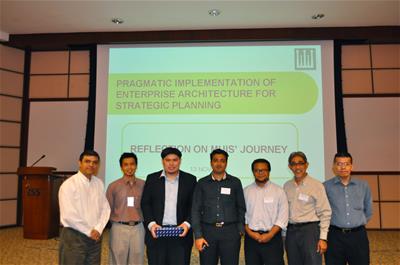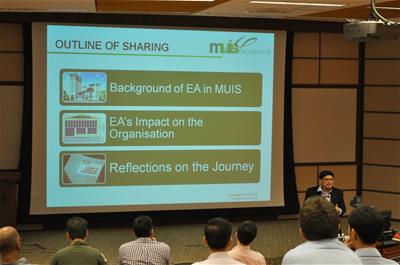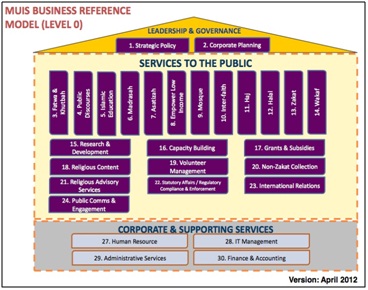The mainstreaming of enterprise architecture (EA) as a management discipline is well underway. Enterprise architecture itself is being re-architected, re-shaped, and re-configured. A Harvard Business Review paper in June 2012 identifies EA as one of the pre-requisites to effective leadership.
Much has been discussed, debated, and written about how the traditional avatar of enterprise architecture tends to be highly IT-centric and IT-driven. Most of today’s enterprise architects are not able to convincingly articulate the value they bring to enterprises. Turning the spotlight on the Islamic Religious Council of Singapore (MUIS) we find out how a business-outcome-oriented EA used EA as a strategic function focused on execution to deliver business outcomes.
Many organisations have functional silos separating business executives and the enterprise architecture teams. Business executives often do not understand EA and how it can add value to them and their business outcomes. EA teams must engage business executives and develop a plan to evolve the relationship to become collaborative, something that the Islamic Religious Council of Singapore (MUIS) aimed to accomplish through its complex and exciting architecture journey.
Creating the Enterprise Context
MUIS, as a statutory body, is responsible for the promotion and administration of religious, social, educational, economic and cultural activities catering to the many and varied interests of Singapore's Muslim community. When embarking on its EA journey, MUIS recognised that it, as part of and a representative of the community is in a cusp of change. Both, internal and external factors influence and impact Singapore’s Muslim community and MUIS had an obligation to be responsive to such emerging challenges.
In June 2011, against this backdrop, MUIS formally initiated its EA programme guided and advised by Dr. Pallab Saha. Right from the start, MUIS leadership put in place mechanisms to ensure that its EA always remains guided by pragmatic implementation.

Dr Pallab Saha (left) with the MUIS team
EA has been embraced as a mean to advocate the need for holistic thinking. Any assumption that the effectiveness of the whole will be achieved automatically, as long as the parts are optimal, does not hold true, and MUIS recognised this early in its journey. With departments segregated by disparate lines of business, the adoption of EA served to integrate management processes and to bring about paradigm shifts in mental models. MUIS had to switch from transactional and reductionist approach to an integrated and joined-up way of doing things in order to meet the emerging challenges gripping the community and to tackle the complexity conundrum it faces. Achieving transformational results were a natural consequence.
“Not many are familiar with how strategic planning and EA work hand-in-hand,” quipped Mohammad Azree Rahim, Assistant Director of MUIS’ Planning & CIO Office, at a recent NUS-ISS’ Architecture Community of Practice Forum, while revealing the chasm between good strategy and poor execution. Although best practices and capability frameworks have always been part of the MUIS’ DNA, Azree added that “you’d be surprised how everyone understands ‘integration’ differently!”

Mr. Mohammad Azree Rahim, Assistant Director of MUIS’ Planning & CIO Office at our recent
Architecture Community of Practice in November.
Building a Culture of Execution
Consistent with NUS–ISS’ long-standing philosophy of leading the practice-based education, very early in the programme, a core team from MUIS successfully completed the Certified Enterprise Architecture (CEITA) executive course. This step firmly established MUIS’ leadership commitment to the journey. This has been invaluable both in creating a very strong core team with adequate knowledge and also for its symbolism within the rest of the organisation. The message was loud and clear – MUIS had decided to move full steam ahead. All through its journey, this has been the backbone to its success – an essential learning for all organisations. Sharing of success stories from other organisations like SingHealth provided crucial motivation in triggering the journey.

By 2012, MUIS was ready for the implementation phase, which entailed business process architecture, content reviews and the development of technology layers. As processes were documented and aligned, the customer-centricity objective became more apparent. “It’s not about the individual departments or their KPIs; it’s about being seen as an integrated organisation,” Azree said. The single integrated perspective was established by creating the MUIS Business Reference Model (BRM). The BRM (see figure) is the central core to all other architecture activities. Articulating a customer perspective by taking an outside-in view made sure that MUIS fulfils its obligation to the Muslim community in a smarter way. The BRM forms the underlying foundation to the vision of One MUIS.
Embracing Systems Thinking
Downstream benefits from its EA include improved responsiveness, reduction of duplicative work and better alignment across various business functions. “For MUIS, it has been about building on existing tools and platforms; there’s no need to start from scratch,” Azree explained.
Weaved into its fourth three-year plan (4M3YP), MUIS aimed to relook and refresh its business goals as the impetus. Using a Scan-Plan-Execute-Review model, MUIS focused on consolidating its resources, “balancing the loops” or moving from current state to a desired outcome, as well as identifying targets for performance tracking. Relevant interventions were identified consisting of policies and programmes, some of which are IT-enabled. Over the course, MUIS has also leveraged business analytics to obtain performance data. The numbers convinced the management and strengthened organisational commitment, whilst providing a real basis for work prioritisation. Ten core projects (or business areas) were eventually identified for full EA implementation.
Realising Change for a Smarter Enterprise
“Change management is never easy. With EA, what’s different is the business perspective, which has forced us to reflect on how we organise our structure and processes from the outside-in, instead of vice-versa,” Azree elaborated. MUIS has used EA as the underlying approach for other related initiatives like Singapore Quality Class and Business Excellence. The role of a committed and passionate EA team, cannot be overstated.
This team has been able to:
- Make EA understood by raising awareness and encouraging acceptance;
- Make EA easy to establish convenience and confidence;
- Make EA desirable by encouraging and emulating leading organisations;
- Make EA rewarding by demonstrating the proof and payoffs; and
- Make EA a habit by reinforcing and reminding.
It is all too common for organisations to seek more examples. Now MUIS has become an example, and the journey continues as success is a choice.
This article is first published in NUS-ISS quarterly e-newsletter, Issue 5 (Jan-Mar 2014).